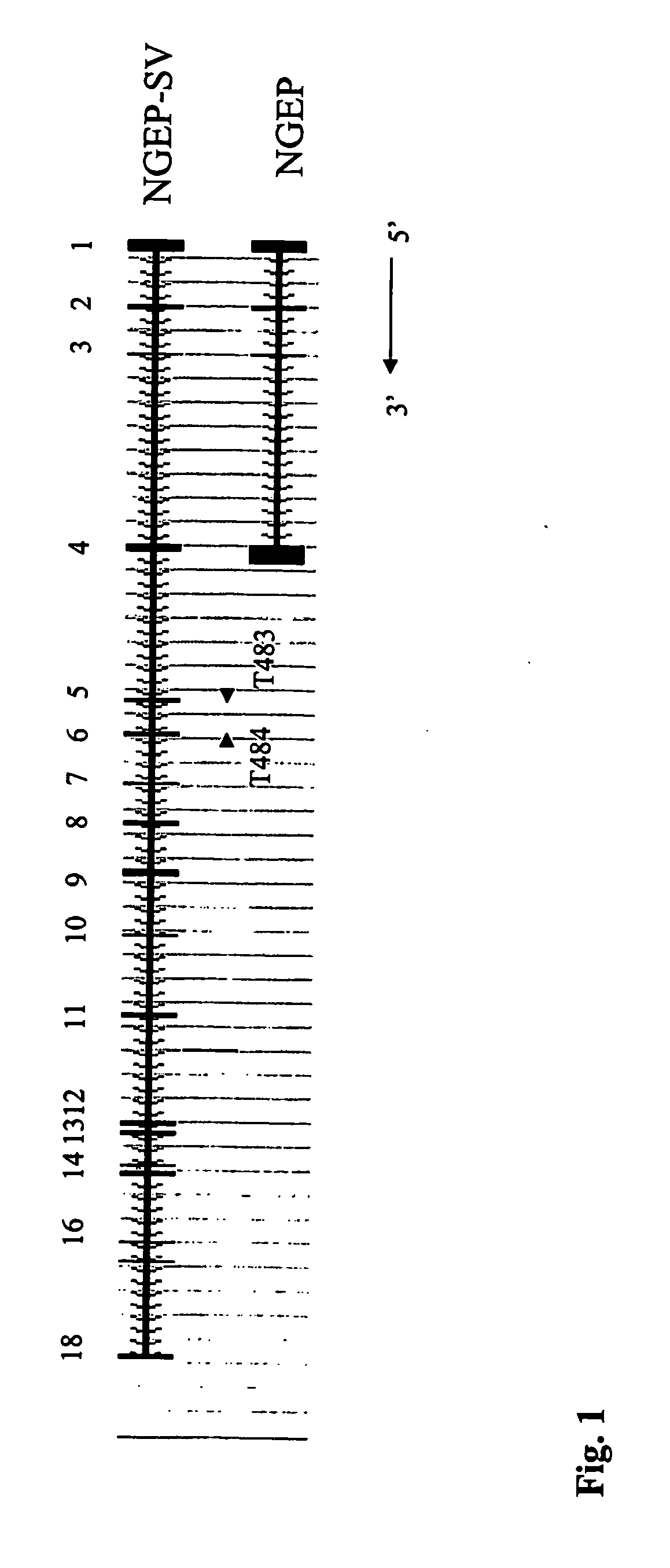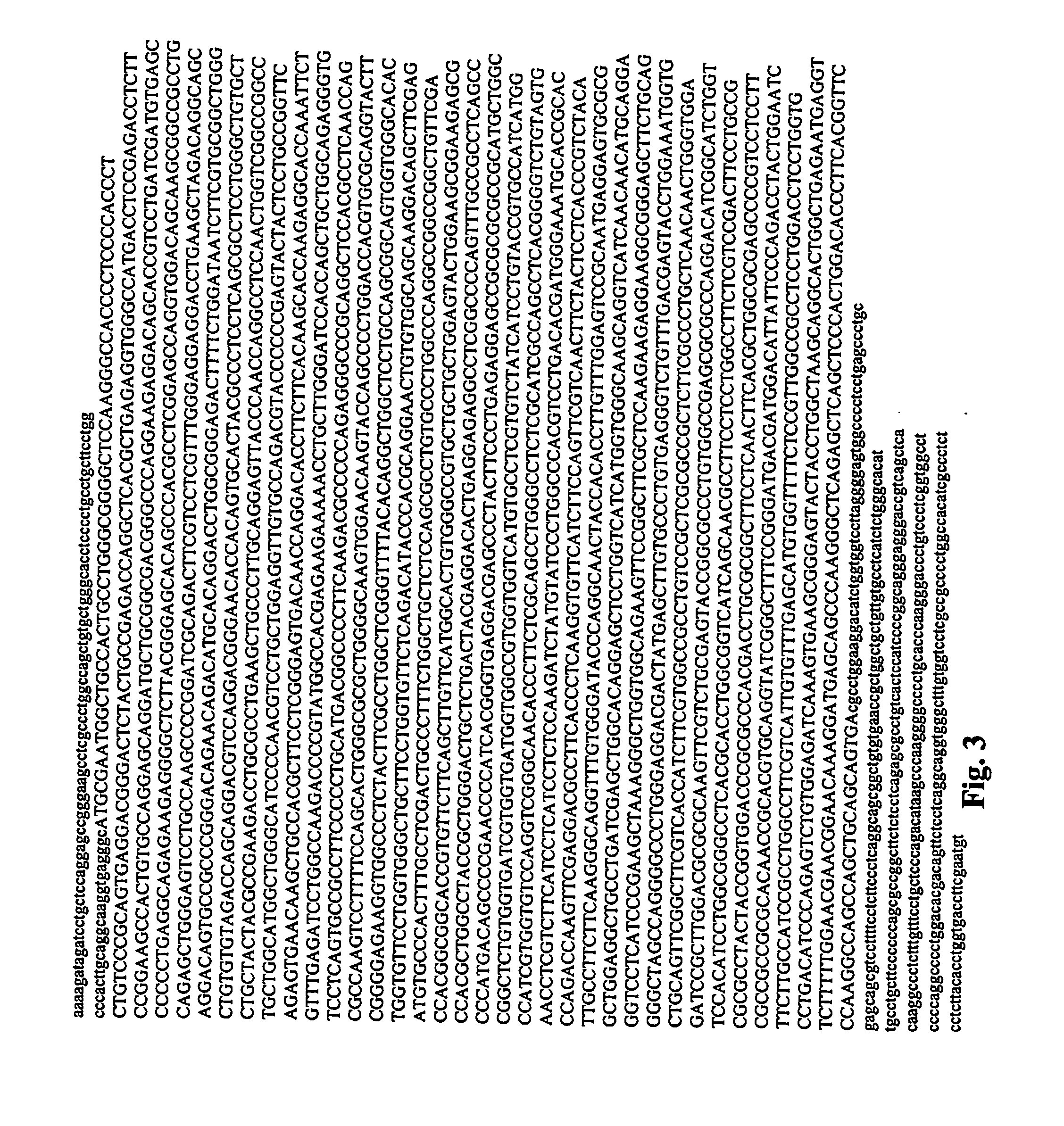Gene expressed in prostate cancer, methods and use thereof
a prostate cancer and gene technology, applied in the prostate field, can solve problems such as early diagnosis problems
- Summary
- Abstract
- Description
- Claims
- Application Information
AI Technical Summary
Problems solved by technology
Method used
Image
Examples
example 1
Identification of Splice Variant of NGEP
[0180] Previously, a new gene (NGEP) expressed in prostate cancer and in normal prostate was identified by EST database mining. NGEP is localized at chromosome 2q37.3 on human genome. There are four exons in NGEP (FIG. 1) and the NGEP transcript has conserved polyadenalyzation sequence at the end of the forth exon followed by polyA tail. The Novel Gene Expressed in Prostate (NGEP) sequence shown in International Application No. PCT / US02 / 36648, filed on Nov. 13, 2002, which claims the benefit of U.S. Provisional Application No. 60 / 336,308, filed Nov. 14, 2001, both of which are incorporated by reference herein in their entirety.
[0181] The NCBI dbEST / CGAP database (see Emmert-Buck et al., Science 274:998, 1996; Krizman et al., Cancer Res. 56:5380, 1996); Strausberg et al., Nat. Genet. 16:415, 1997), was used as a source for cDNA sequences. The ESTs from human tissues and tumors were downloaded from the NCBI EST database. The cDNA libraries tha...
example 2
Expression Analysis of NGEP Splice Variant in Normal Tissues
[0183] The expression of the new EST sequence was determined in different normal tissues. Specifically, a multi-tissue Dot blot analysis was performed using a 32P labeled PCR generated DNA fragment as a probe.
[0184] The human multiple tissue RNA blot (RNA Masterblot, Clontech, Palo Alto, Calif.) and Northern blot (Multiple Tissue Northern blot, Human II, Clontech) hybridizations were carried out as described previously (Liu et al., Biochem. Biophys. Res. Commun., 264:833, 1999). Briefly, RNA hybridizations with multiple tissue RNA Dot blot and Northern blot were performed as follows: membranes were pre-hybridized for 2 h in hybridization solution (Hybrisol I; Intergen, Purchase, N.Y.) at 45° C.
[0185] The cDNA probe utilized in these studies was produced from a PCR fragment generated using the primer pair:
T483:CAGGACGTCCAGGACGGGAACACCA;(SEQ ID NO:11)andT484:AGCTTGTTCACTCTGAACCGGC.(SEQ ID NO:12)
[0186] The probe was label...
example 3
Cloning and Analysis of the Spliced Variant of Ngep cDNA
[0188] Northern analysis of NGEP detected several bands of different sizes only in the prostate lane. The smallest band was about 900 bp in size. A Northern analysis was performed to determine if the high molecular weight bands, which were detected by the NGEP probe, were also part of the new prostate EST (SV-NGEP). The PCR generated probe that was used for the Dot blot analysis was also used in the experiment described herein. Methods are described in Example 2.
[0189] As shown in FIG. 3, two specific bands (approximately 4.4 and 4.6 kb) were detected only in the prostate lane. These two bands were similar in size to the high molecular weight bands observed in NGEP analysis.
[0190] Using PCR primers from NGEP sequence and the sequence from new prostate EST (termed SV-NGEP) about a 2.0 kb cDNA fragment was cloned. Complete nucleotide sequence of the cDNA and the amino acid sequence encoded by this DNA fragment is shown in FIG....
PUM
| Property | Measurement | Unit |
|---|---|---|
| Fraction | aaaaa | aaaaa |
| Fraction | aaaaa | aaaaa |
| Time | aaaaa | aaaaa |
Abstract
Description
Claims
Application Information
 Login to View More
Login to View More - R&D
- Intellectual Property
- Life Sciences
- Materials
- Tech Scout
- Unparalleled Data Quality
- Higher Quality Content
- 60% Fewer Hallucinations
Browse by: Latest US Patents, China's latest patents, Technical Efficacy Thesaurus, Application Domain, Technology Topic, Popular Technical Reports.
© 2025 PatSnap. All rights reserved.Legal|Privacy policy|Modern Slavery Act Transparency Statement|Sitemap|About US| Contact US: help@patsnap.com



